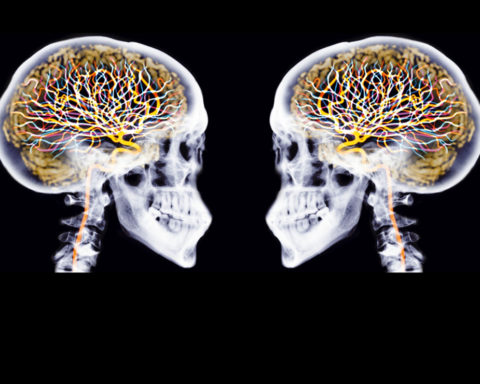A study by British scientists has just been published in the Proceedings of the National Academy of Sciences, and it is chilling. Toxic nanoparticles linked to air pollution have just been found "in abundance" in brain tissue and could be directly linked to Alzheimer's disease, which affects tens of millions of people worldwide. The study was carried out on a small sample of 37 people and needs to be further investigated to be fully validated, but the lead it has just opened up is certainly promising.
Aesearchers have long since identified the presence of nanoparticles in brain tissue. But until now, scientists thought that these particles were naturally produced by our bodies. British researchers at Lancaster University have managed to show that some of these particles in our brains are not natural but are a direct result of air pollution.
" This is a discovery that should lead us to re-examine environmental risk as an important factor in Alzheimer's disease. "said the British daily newspaper The Guardian...Professor Barbara Maher, who led this research. The time has come," she adds. continue to carry out epidemiology and toxicity testing on these highly prolific particles to which the population is widely exposed ".
Millions of magnetite particles in the brain
The Lancaster University team examined the brain tissue of 37 people aged 3 to 92 years in Manchester, England and Mexico City. Each of these brains contained nanoparticles of a highly magnetized iron oxide, magnetite. And it wasn't just a few traces! Scientists point out that these elements were found in abundance: " We're talking millions of magnetite particles per gram of freeze-dried brain tissue.... Which is extraordinary. "says Professor Maher.
When the researchers made this discovery, they wanted to know where these particles came from. In further research, they discovered two types of magnetite particles in brain tissue: round particles and angular, crystalline shapes. The round ones outnumbered the crystalline ones by a ratio of 1 to 100.
The crystalline forms of magnetite particles are, for researchers, likely to have a natural source. They are derived from the iron found in the cells of our body. On the other hand, the round particles, the most numerous, "round" ones, "round" ones, "round" ones, "round" ones, "round" ones, "round" ones, "round" ones, "round" ones, "round" ones, "round" ones, "round" ones, "round" ones, "round" ones, "round" ones, "round" ones, "round" ones, "round" ones, "round" ones, "round" ones, "round" ones, "round" ones, "round" ones, "round" ones, "round" ones, "round" ones, "round" ones, "round" ones, "round" ones, "round" ones, "round" ones, "round" ones, "round" ones, "round" ones, "round" ones, "round" ones, "round" ones, "round" ones, "round" ones, "round" ones, "round" ones, "round" ones, "round" ones, "round" ones, "round" ones, "round" ones. are very rounded nanospheres, because they were formed as molten droplets of material from combustion sources such as tailpipes, industrial processes and power plants, wherever you burn fuel. "says Barbara Maher
She also says that her teams have found nanoparticles of other metals such as cobalt, nickel and platinum. Platinum is very rarely found naturally in the body, but is found in a large number of car engines.
The air pollution in question?
There is only one step from criminalizing air pollution as a polluting agent for our brain cells and as a factor in Alzheimer's disease that scientists, out of prudence and ethics, do not take. The study that has just been published concerns a very small panel of the population. Many more samples of brain tissue would be needed to corroborate the initial results. The fact remains that the traces of magnetite found in abundance in these brains are not a good thing. « Magnetic nanoparticles in the brain is never very good. "says Barbara Maher. They are particularly toxic and produce reactive oxygen molecules, free radicals, which have also been linked to aging and neurological disease.
" Cellular oxidation damage is one of the hallmarks of Alzheimer's disease. "says the director of the research team. A recent paper has indeed shown that magnetite was directly associated with damage identified in the brains of Alzheimer's patients. Air pollution has been linked to a significant increase in the risk of Alzheimer's disease by a significant study published in 2015, while other research have shown Alzheimer's disease-related brain damage in children and young adults exposed to air pollution. Air pollution has also been linked to dementia in older men and women.
Magnetite in the nostrils
How can such particles penetrate the brain and force the blood-brain barrier?
Professor David Allsop, a recognized expert on Alzheimer's disease at Lancaster University and a member of the research team, states : " There's no blood-brain barrier in the nasal system. Once nanoparticles enter the olfactory areas of the brain directly through the nose, they can spread to other areas of the brain, including the hippocampus and cerebral cortex, areas that are particularly affected in Alzheimer's disease. ». The doctor says he is "It is interesting to note that a deterioration in sense of smell is an early indicator of Alzheimer's disease. ".
So even if the link between pollution and Alzheimer's requires further research to be formally established, we are, with this study, faced with a body of evidence that should not be overlooked. Evidence that is accumulating with other evidence, such as that from a study published in 2015 stating that air pollution contributes to the premature death of some 3.3 million people worldwide each year and that this figure could double by 2050. This did not include the risks of degenerative brain diseases, which are predicted to affect 100 million people worldwide by 2050, or 1 in 85 people on Earth.
The research of Professor Maher's team has been published in the Proceedings of the National Academy of Sciences (the paper has not been made public at the time of writing).













